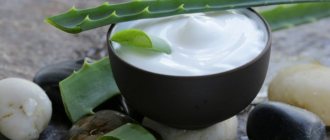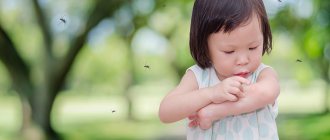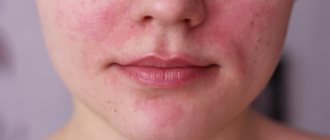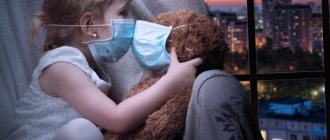Pediatrician
Sayfulina
Maryam Zakareevna
32 years of experience
Pediatrician of the highest category, member of the Union of Pediatricians of Russia
Make an appointment
Miliaria in children under one year of age and older is a fairly common skin lesion, which is a rash caused by severe sweating or poor care of the child’s delicate skin. It is important to understand that the baby’s thermoregulation processes are not yet perfectly established, and therefore the slightest negative factors can cause an undesirable reaction - parents should not be scared and think that this is a rare phenomenon. Almost all kids go through this.
However, you shouldn’t treat this problem negligently either: ordinary heat rash without treatment tends to become more complicated and worse, and in this case, longer and more complex treatment will be required - it’s better not to let it get to that point.
Symptoms
Symptoms of prickly heat in children include:
- The appearance of a characteristic rash on the neck, in the ear area, on the back of the head, along the hairline, armpits, in the upper chest, as well as on the back, in the groin folds and on the buttocks.
- Small rashes in the form of bubbles with transparent contents. In more complex cases, these are reddish nodules with an inflamed rim. The rash reacts to temperature, so it can decrease or increase depending on the environment.
- Weeping lesions - they occur when there is extensive damage to the skin.
- Pustules, swelling, redness of the skin and a putrid odor. This is not so much a symptom of prickly heat in children, but a signal that a bacterial or fungal infection has joined it.
- Soreness, itching and other unpleasant sensations that cause anxiety in the child make him capricious. This is not observed with ordinary heat rash, but if the condition is complicated, such negative factors will progress, simultaneously causing an increase in body temperature.
At any stage of heat rash in a child, even if it is very mild, it is necessary to consult a pediatrician. If complications arise, you should immediately consult a doctor - such issues are dealt with either by a pediatrician or a pediatric dermatologist.
What causes prickly heat
The appearance of this disease is indicated by small pink spots, not prone to inflammation, which appear in places of high humidity (armpits, on the bends of the arms and legs, in the groin and buttock folds) and almost never appear on the face. Their cause is specific substances contained in sweat, as well as insufficient skin ventilation and non-compliance with hygiene rules.
Sometimes parents notice that a problem exists quite by accident, for example, during a routine consultation with a neurologist or otolaryngologist, looking into the armpit of an overheated, overly wrapped up baby. The child is noticeably irritated when clothes touch the inflamed areas of the skin, but he is not bothered by itching, as is the case with allergies: he does not feel the desire to scratch.
As a rule, the disease goes away on its own as soon as a hygiene regime is established. After the first treatment with clean water and soap, the spots fade and decrease. Not everything is so simple with allergic dermatitis, which always requires treatment.
Causes
The main cause of heat rash in a child is overheating, and it is caused by various factors, including:
- Too warm, and synthetic clothes at that.
- Untimely changing of diapers, especially in hot weather or in a warm room.
- A minimal amount of air baths and infrequent bathing, due to which the skin is not cleansed and does not breathe.
- Using cosmetics that are too oily and thick on the skin, which does not allow heat to be released properly.
- Diseases associated with fever. Especially if parents also use warming treatment methods.
To overheating we will add such factors as allergies to various materials, friction and pressure of clothing, effect on irritated areas of feces and urine.
It may seem that the causes of heat rash in children are due solely to parental care errors, but this is absolutely not the case. There are children who themselves are prone to developing this condition. These are allergy sufferers, overweight children, children with various endocrine diseases (for example, diabetes). Also at risk are formula-fed children and premature newborns. When caring for such babies, you should be especially attentive to the condition of the skin and body.
How can you tell if a person is experiencing anaphylactic shock?
Anaphylaxis is the body's reaction to contact with an allergen, expressed in the sudden release of histamine in large quantities. This, in turn, causes involuntary contraction of smooth muscles, which is fraught with bronchospasm and suffocation.
The reason may be: • taking a medicine containing an allergen; • administration of tetanus antitoxin; • contact with latex; • poisonous insect bite; • consumption of seafood, nuts, eggs. Physical activity, taking non-steroidal anti-inflammatory drugs, and exposure to cold increase anaphylaxis.
Symptoms develop within 15 minutes after contact with the irritant. Hives, sneezing, and fever suddenly occur. The patient's heart rate increases, blood pressure decreases, and breathing becomes difficult. A few minutes later he loses consciousness.
Diagnostics
A pediatric dermatologist or pediatrician will examine the child and interview the parents, as well as a series of studies to rule out dermatitis, chickenpox, scarlet fever and many other diseases with similar symptoms. Most often, a visual examination is enough, but tests (scraping) may be required to help identify the causative agent of a secondary infection (if one is observed). A general and biochemical blood test is often done, as well as an analysis of the contents of the vesicles - it all depends on the recommendations of the attending physician.
Caring for a child with allergies
Cool air is preferable for allergy sufferers. Children with skin lesions, allergic rhinitis, and asthma live easier at a temperature of 18-22 °C and a humidity of at least 50%.
Children with allergies need to be bathed daily. In this case, the water temperature should be 32-36 °C, and the duration of swimming should not be more than 10 minutes.
With atopic dermatitis, children's skin needs intensive hydration after bathing. For this purpose, special creams and ointments are used. Without sufficient hydration, the skin quickly becomes dry and easily injured.
In children with allergies, it is important to regularly determine the level of vitamin D in the blood. A sufficient content of this substance in the body reduces skin permeability and serves as a barrier to the penetration of allergens.
Vaccinations are not contraindicated for allergy sufferers, but they should be carried out during remission.
Online consultation with a pediatrician
consultation cost: 500 rubles
Online consultation
During the consultation, you will be able to voice your problem, the doctor will clarify the situation, interpret the tests, answer your questions and give the necessary recommendations.
Treatment
Usually, treatment of prickly heat in a child is carried out comprehensively and includes the following points:
- Maintaining optimal temperature in the house - no more than 20-22 degrees Celsius. The same goes for humidity, which needs to be monitored - 50-70%.
- The right choice of clothes. It must be appropriate for the temperature and not be synthetic or too dense.
- Regular hygiene procedures - washing, bathing using gentle cosmetics designed specifically for children's delicate skin.
- Regular diaper changes. Your baby's skin should always be clean and dry.
- Use of medications and other means prescribed by a doctor. Sometimes decoctions of medicinal herbs are allowed, but only when the doctor allows it. For the rest, specially selected ointments, powders and other medications are used. In difficult cases, antifungal drugs and antibiotic-based ointments can be used - but parents should not purchase such products on their own.
As a rule, when prickly heat appears in a child, the prognosis is good. After establishing hygiene procedures, the problem disappears quite quickly. If the baby’s immunity is severely weakened, and a dangerous infection develops against the background of prickly heat, there is a risk of complications. In this case, the treatment will be longer and more complex, and in exceptional cases it will require hospitalization of the child.
If your baby exhibits symptoms of infant heat rash, do not wait until complications begin - be sure to contact pediatricians or dermatologists at Meditsina JSC - get examined by a doctor, get an accurate diagnosis and an effective treatment plan.
What you should never do if you have heat rash in a child
Before visiting specialists, many parents try to help their child on their own and use various tips from the Internet. This should not be done under any circumstances. We have compiled a short list of what is prohibited:
- Squeeze and open the blisters on the baby’s skin.
- Cover inflammations and blisters with iodine or brilliant green, as well as other aggressive agents.
- Moisturize the skin with any available means. Heavy moisturizing creams are often used, which in this case are strictly contraindicated.
- Dry wet areas with rough materials or sudden movements. If it is necessary to remove moisture, this is done with very clean, soft and highly absorbent material - with extremely careful and smooth movements.
But it is best to immediately visit a doctor and get detailed advice about what you can and cannot do.
Prevention of allergies in a child after birth
Only breastfeeding a baby until at least 5-6 months will reduce the risk of developing allergies.
Complementary foods are introduced during the “tolerance window” period (4-8 months), when the child reacts to new foods with minimal allergic manifestations.
It is better to prepare complementary foods yourself. This way, parents can choose a heat treatment option that will reduce the likelihood of developing allergies. Long-term cooking (at least 20 minutes) followed by removal of the water in which the product was cooked is preferable.
It has been proven that if a child lives in the same room with pets for up to a year, then in the future he may develop immunity to allergens from cats and dogs.
It is important to maintain a hypoallergenic lifestyle - a minimum of carpeting, rugs, and heavy curtains.
All these things are dust collectors. Wet cleaning is carried out at least 2 times a week.
Polina Vasilyeva
dermatologist
| Rashes can be treated with products containing zinc oxide (sudocrem), or diaper cream, powder. If you are concerned about itching, a cream with dexapanthenol (“Bepanten”, “Bepanten plus”, “Cicaplast”) or soothing creams that are sold in pharmacies will help. The products “Drapolen”, “Bepanten”, “Desitin” - their It is recommended to apply a thin layer and do not put on the diaper until completely absorbed. |
Sunburn
With the arrival of summer, we want to spend more and more time outdoors, under the sun, recharge with energy and get a beautiful tan. But sometimes you don’t notice how you get a sunburn instead of a tan. Why does this happen and what is a sunburn?
Sunburn is an acute inflammation of the skin in response to ultraviolet radiation from the sun. It manifests itself as redness, swelling of the skin and pain, in severe cases - vesicles and blisters. The mechanism of sunburn formation is as follows. Sun rays damage skin cells, damaged cells cause the release of inflammatory mediators, which leads to the development of an inflammatory reaction in the skin. It is these symptoms that cause anxiety to a person and force them to look for a remedy to alleviate this condition. Traditional sunburn remedies cool, moisturize, and help repair damaged skin cells, but do not eliminate acute inflammation.
It takes time to restore the skin using traditional means. However, there are drugs that can help quickly.
Beloderm Express spray quickly relieves inflammation of the skin and eliminates redness, soreness, and swelling. The sooner the spray is applied to the skin, the better. Application of Beloderm Express within the first 3 hours after a sunburn prevents subsequent severe peeling of the skin and the formation of age spots. Since peeling of the skin is also associated with its dehydration, it is advisable to use moisturizing creams after a sunburn, for example the hypoallergenic cream Aflocrem.
How to identify prickly heat
With deep heat rash, the rashes are quite large (up to 3 mm in diameter). In infants it has a pale red color and appears sharply in areas of overheating. Usually such a rash goes away within a few days after eliminating the cause of its occurrence.
Papular miliaria occurs mainly in adults. The symptoms are very similar to crystalline ones: bodily bubbles with cloudy liquid, which subsequently burst. Only these blisters do not create large lesions, but appear throughout the body in single rashes.
Despite the great similarity of skin inflammations, which have completely different causes, there are features that can be used to almost accurately determine the nature of the rash. So, how to distinguish heat rash from allergies in a baby? Do a little experiment. Simply apply pressure or stretch the skin where the pimples are most concentrated. It is in this place that it will acquire a natural color and the redness will disappear. With the cessation of mechanical action, the rash returns to its original appearance, which does not happen with allergic dermatitis.
How to distinguish allergies from prickly heat, so as not to trigger an allergic reaction that can cause complications? If any rash appears on a child’s body, to determine the cause, you should pay attention to the following factors:
- localization of rashes - single or form large groups;
- visual character – red or flesh-colored, etc.;
- time of appearance – absence of transformations and stages of element formation.
Parents should examine their baby's skin during daily bathing. This will help to more accurately determine the cause of the rash if detected in a timely manner, and to accurately understand whether it is prickly heat or an allergy.
If a child develops a rash immediately after introducing new foods to the diet, using other hygiene products, or taking medication, then this is an allergic reaction. If the blisters appear after a walk, a trip, or in a situation where the child was in a diaper for a long time in a hot room, it is likely that it is prickly heat.
Mechanism of development of prickly heat
An increase in body temperature leads to the activation of protective mechanisms for cooling it - the pores open and sweat appears, which cools the body.
If the sweat glands are clogged with sebum, cosmetics, or if the air is humid and hot, then the sweating process suffers. Sweat evaporates slowly, causing skin irritation.
Sweat contains salts and biologically active substances that can have an irritating effect on the skin. If excess sweat is not removed in a timely manner, the microbes that are always there begin to actively multiply on the skin - the process of inflammation of the sweat glands occurs - prickly heat, a small rash, is formed, accompanied by various subjective unpleasant symptoms.
Course of allergy
- Allergies in children can develop instantly - for example, in the case of an ant bite - or over several months, as happens when it is caused by cat fur or pollen. It all depends on how often the child comes into contact with the allergen.
- Seasonal allergies occur every year in the spring, summer and fall, and mold allergies can develop if there is prolonged rain outside and humidity levels in the home have increased, leading to the growth of microorganisms.
- It is important to understand that allergies in children can come and go, and there is no exact explanation for this.









